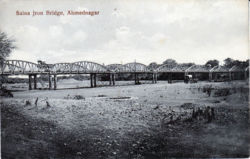Ahmadnagar
| Ahmadnagar | |
|---|---|

| |
| Presidency: Bombay | |
| Coordinates: | 19.095003°N 74.756679°E |
| Altitude: | 649 m (2,129 ft) |
| Present Day Details | |
| Place Name: | Ahmednagar |
| State/Province: | Maharashtra |
| Country: | India |
| Transport links | |
| Dhond-Manmad State Railway | |
| FibiWiki Maps | |
|---|---|
| See our interactive map of this location showing places of interest during the British period | |
| Ahmadnagar |
Ahmadnagar was the headquarters of Ahmednagar District in the Central division of Bombay Presidency during the British period. See Bombay Districts.
Ahmednagar Fort, in Ahmednagar city, was the centre of the British cantonment used by artillery and infantry units, primarily between 1849 and 1921. "The Fort is in the centre of the cantonment, 2½ miles N E of the railway station. Close to it are Christ Church and a R C Church. The European Barracks are 1 mile S E of it". [1]
In 1913 a Remount Depot was established to house 500 horses. In 1921, six Armoured Car companies were based there and in 1924 a Royal Tank Corps School was established at Ahmednagar. This School was the forerunner of the Fighting Vehicle School, and the area is now occupied by the Indian Armament & Electronics Regiment.
A remote hillside about six miles outside the city at Arangaon was leased by the British Indian Army towards the end of the First World War to house two (plague) segregation camps, supervised by the 2nd/102nd King Edward's Own Grenadiers and the 2nd/128th Pioneers of the Indian Army in 1919 on what later became known as Meherabad Hill.[2]
Ahmednagar was also the location of the Machine Gun School from the early 1920s.
Contents
Spelling Variants
Modern name: Ahmednagar
Variants: Ahmednuggar/Ahmednuggur/Ahmadnagar
FIBIS resources
- FIBIS database Ahmednagar Christian Cemetery. Inscriptions have been transcribed from gravestones at the cemetery. The graves photographed and transcribed include some German POWs/civilian internees from WW1 and a memorial to Boer POWs who died there. Images are also available, which are part of the FIBIS Cemeteries Project, and may be ordered for a modest donation.
History
Military history
Battle of Ahmednuggur 1803
Battle of Ahmednuggur 1804
Prisoner of War Camps at Ahmednagar
There was a Boer POW camp during and after the Boer War, and a POW/internment camp for civilians during the First World War
See POW Camps in India
Churches
- Christ Church, Ahmednagar
External links
- Ahmadnagar Imperial Gazetteer
- "Where freedom held fort" by Himmat Singh Gill Sunday, September 3, 2006 tribuneindia.com. The Ahmednagar Fort held political prisoners in the 1940s including Pandit Jawaharlal Nehru
- Scroll down Incredible Ahmednagar, for details of the Tank Museum, established by the Armored Corps Centre and School, Ahmednagar in February 1994. Photographs on picasaweb rahul m’s Gallery, morakhandi v’s Gallery. Article "Tanks down the years" by Rajendra Rajan, tribuneindia.com Sunday, May 24, 2009
- Ahmednagar: Fort: Boer And German POWs Held By The British YouTube Video. Contains some cemetery images.
- Photographs:Ahmednagar Fort. flickr.com. Retrieved 20 September 2014
- YouTube videos from the National Army Museum
- Christ Church Ahmednagar Retrieved 20 September 2014. Includes a Cemetery Search.
- "Ahmednagar and the Commencement of the Central India Campaign in the Indian Mutiny" 18 April 2010. Nick Balmer's Sepoys and Griffins. The comments following the article also include information about present day Ahmednagar. Retrieved 20 September 2014
Historical books online
- "Ahmadnagar City" Imperial Gazetteer of India, Volume 5, page 123.
- Ahmednuggar page 128 Sketches of a Soldier's Life in India by Staff Sergeant Thomas Quinney, Hon. East India Company’s Service, 1853 Google Books. He arrived in Bombay May 1827 and transferred to the Bombay Artillery c 1830. He was invalided in January 1841.
- Ahmednuggur, in the Deccan, is listed in a List of all the military stations in the Bombay Presidency, with details, page 235 Transactions of the Medical and Physical Society of Bombay, Volume VII, New Series 1861 Google Books
- Ahmednuggur page 456 Report of the Commissioners Appointed to Inquire into the Sanitary State of the Army in India : with Abstract of Evidence, and of Reports Received from Indian Military Stations 1864 Archive.org
- Memorial papers of the American Marathi Mission, 1813-1881 1882 Archive.org. The Ahmednagar Mission
- Tales of Ahmednagar by Captain Cecil Cowley, 2nd Garrison Battalion, Northumberland Fusiliers 1919 Archive.org. History of Ahmednagar, mostly for the pre British period.
References
- ↑ Page 347 A Handbook for Travellers in India, Burma, and Ceylon published by John Murray, London, Eighth Edition 1911
- ↑ Greveson, Alan. Alan Greveson's World War 1 Forum. Scroll down to Mick’s post dated 20th November 2012 and Alan Greveson's reply of the same date regarding buildings purchased at an abandoned military camp by early followers of Meher Baba in the 1920s. Retrieved 19 June 2016.
- ↑ Comment by sunilsamuel 4 February 2011 In '"Sepoys and Griffins", see External links
- ↑ FIBIS Database Group Memorials, Percy-Smith/Bullock Papers. Individual names do not appear to be available.